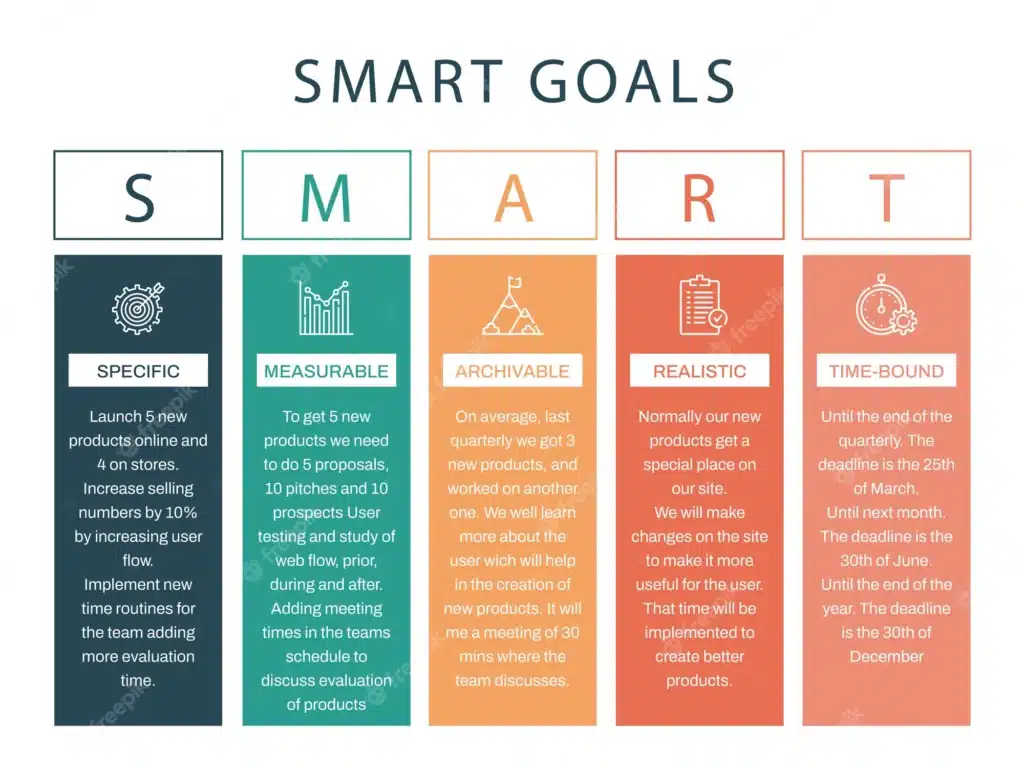Setting goals is the compass that directs us toward our desired destinations. Whether they are personal or professional, big or small, effective goal-setting requires a thoughtful and strategic approach. In this comprehensive guide, we will delve into 9 tips that will empower you into setting goals that are meaningful, attainable, and fulfilling. By applying these actionable insights, you’ll be well-equipped to embrace the journey of growth and self-discovery while successfully realizing your dreams.
1. Discover Your Vision
To embark on a successful goal-setting journey, it’s crucial to have a clear vision of what you want to achieve. Take some time to reflect on your passions, values, and aspirations.
Ask yourself what truly motivates and excites you, and use these insights to craft a vision statement. Your vision statement will act as the driving force behind your goals, providing you with a strong sense of purpose and direction.
While ambition is commendable, setting unattainable goals can lead to disappointment. Strike a balance by challenging yourself without setting yourself up for failure.

2. Set Specific and Measurable Goals
Concrete and measurable goals are the building blocks of success. When setting goals, be precise about what you want to accomplish and define quantifiable metrics to gauge your progress.
Specificity eliminates ambiguity and fosters focus, enabling you to channel your efforts more effectively. Determine which goals are most important and prioritize them accordingly. Setting realistic timelines for each goal helps maintain focus and prevents feeling overwhelmed.
3. Embrace the S.M.A.R.T. Approach
The S.M.A.R.T. approach is a time-tested methodology for goal-setting that stands for Specific, Measurable, Achievable, Relevant, and Time-bound. This framework ensures that your goals are well-defined, realistic, and aligned with your overall vision. It also instills a sense of urgency, motivating you to take consistent action toward your aspirations.

4. Break Down Complex Goals
Tackling overwhelming goals can be daunting. To make them more manageable and less intimidating, break them down into smaller, achievable milestones. Celebrating these milestones along the way will boost your motivation and confidence, propelling you forward with renewed vigor.
Large objectives can be daunting. Divide them into smaller, manageable tasks to foster a sense of accomplishment and momentum.

5. Prioritize Setting Goals
As you set multiple goals, consider their relative importance and prioritize accordingly. Focus on a few key goals at a time, giving each one the attention and effort it deserves. This prevents spreading yourself too thin and enhances your chances of success. Setting too many goals at once may lead to burnout. Focus on a few significant goals to give each the attention it deserves.
The Pomodoro Technique
The Pomodoro Technique is a time management method that encourages individuals to work in short, focused intervals, separated by regular short breaks. Each work interval, typically known as a “Pomodoro,” lasts for 25 minutes, followed by a 5-minute break. After completing four Pomodoros, a longer break of 15-30 minutes is taken. This structured approach aims to enhance concentration, prevent burnout, and balance productivity and well-being.
Evaluate the Importance and Impact When Setting Goals
Take the time to assess the importance and potential impact of each goal. Consider how achieving a specific goal aligns with your overall values, vision, and aspirations. Prioritize goals that will have a significant positive effect on your life, career, or business. Focus on goals that contribute to your long-term growth and fulfillment rather than short-term gratification.
Apply the Urgency-Importance Matrix
Utilize the Eisenhower Matrix, which categorizes goals based on their urgency and importance. Divide your goals into four quadrants: Urgent and Important, Important but Not Urgent, Urgent but Not Important, and Neither Urgent nor Important. Prioritize goals falling into the Urgent and Important quadrant, followed by Important but Not Urgent. Delegate or eliminate goals in the other two quadrants if possible.
6. Cultivate Self-Compassion When Setting Goals
Goal-setting can be challenging, and setbacks are inevitable. Practice self-compassion and recognize that perfection is not required. Treat yourself with kindness and understanding during moments of difficulty, and use setbacks as learning opportunities to grow and refine your approach. Be kind to yourself throughout the goal-setting process. Acknowledge that progress takes time, and setbacks are natural.
Embrace Imperfection
Understand that nobody is perfect, and goal setting is a process filled with ups and downs. Accept that setbacks and mistakes are a natural part of the journey and avoid harsh self-judgment when things don’t go as planned.
7. Stay Accountable and Track Progress
Accountability is a powerful driver for goal achievement. Share your goals with someone you trust, such as a friend, mentor, or coach, who can support and encourage you throughout your journey.
Additionally, track your progress regularly to stay on course and make necessary adjustments as needed. Regularly assess your progress toward your goals. Celebrate achievements and analyze setbacks to refine your approach.
8. Stay Resilient in the Face of Challenges
The path to achieving goals is seldom smooth. Challenges and obstacles are bound to arise, but resilience is the key to overcoming them. Embrace a growth mindset, view challenges as opportunities for growth, and remain steadfast in your determination to persevere. Engage with mentors, friends, or colleagues who can provide valuable feedback and support, enriching your goal-setting journey.
Embrace a Growth Mindset
Adopt a growth mindset, where you view challenges and setbacks as opportunities for learning and improvement. See obstacles as stepping stones towards your goals, and believe in your ability to overcome them with dedication and effort.
Practice Mindfulness
Engage in mindfulness practices to become more aware of your thoughts and emotions. When facing challenges or setbacks, observe your inner dialogue without judgment and offer yourself kindness and understanding.
9. Celebrate Success and Learn from Failures Throughout Setting Goals
Acknowledge and celebrate your achievements, regardless of their magnitude. Celebrating milestones, big or small, fuels your motivation and reminds you of your progress. Similarly, embrace failures as valuable lessons that contribute to your growth. Extract insights from setbacks and apply them to future endeavors.

Conclusion
Embarking on a journey of setting and achieving goals requires dedication, focus, and a willingness to learn and adapt. By applying these 9 tips on setting goals, you’ll be well-equipped to navigate the challenges, maintain motivation, and stay true to your vision. Embrace the process of goal-setting as a transformative experience that empowers you to reach new heights and unlock your full potential. Remember, success is not merely reaching the destination but embracing the growth and self-discovery that come with the journey. So, take the first step today, and let your aspirations soar to new heights!




